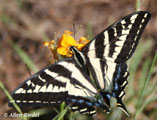Native Plants
Search for native plants by scientific name, common name or family. If you are not sure what you are looking for, try the Combination Search or our Recommended Species lists.
Prunus emarginata
Prunus emarginata (Douglas ex Hook.) D. Dietr.
Bitter Cherry
Rosaceae (Rose Family)
Synonym(s):
USDA Symbol: prem
USDA Native Status: L48 (N), CAN (N)
Thicket-forming shrub or small tree with rounded crown, slender, upright branches, bitter foliage, and small, bitter cherries.
This is the most common western cherry. The scientific name describes the notched petals. As the common name indicates, the fruit is not edible; like the bark and leaves, it is intensely bitter. However, the fruit is consumed by many songbirds and mammals and the foliage is browsed by deer and livestock.
Plant Characteristics
Duration: PerennialHabit: Tree
Fruit Type: Drupe
Size Notes: Up to about 50 feet tall.
Leaf: Green
Fruit: Red
Bloom Information
Bloom Color: White , PinkBloom Time: Apr , May , Jun , Jul
Distribution
USA: AZ , CA , ID , MT , NM , NV , OR , UT , WA , WYCanada: BC
Native Distribution: British Columbia, Washington, and W. Montana south to S. California and SW. New Mexico; to 9000' (2743 m) in south.
Native Habitat: Moist soils of valleys and on mountain slopes; in chaparral and coniferous forests.
Growing Conditions
Water Use: MediumLight Requirement: Sun , Part Shade , Shade
Soil Moisture: Moist
CaCO3 Tolerance: Medium
Benefit
Use Wildlife: Seeds contained in the bright red cherries are eagerly harvested by Evening Grosbeaks in early autumn.Warning: The seeds of all Prunus species, found inside the fruits, contain poisonous substances and should never be eaten. Sensitivity to a toxin varies with a personís age, weight, physical condition, and individual susceptibility. Children are most vulnerable be
Conspicuous Flowers: yes
Attracts: Butterflies
Larval Host: Admiral, Azure, Swallowtail (larval), orange tip, elfin, and blue (nectar) butterflies.
Nectar Source: yes
Value to Beneficial Insects
Special Value to Native BeesThis information was provided by the Pollinator Program at The Xerces Society for Invertebrate Conservation.
Butterflies and Moths of North America (BAMONA)
|
Pale Swallowtail (Papilio eurymedon)  Adult Food Source |
Find Seed or Plants
Find seed sources for this species at the Native Seed Network.
National Wetland Indicator Status
| Region: | AGCP | AK | AW | CB | EMP | GP | HI | MW | NCNE | WMVE |
| Status: | FACU | FAC | FACU |
From the National Organizations Directory
According to the species list provided by Affiliate Organizations, this plant is on display at the following locations:Santa Barbara Botanic Garden - Santa Barbara, CA
Native Seed Network - Corvallis, OR
Bibliography
Bibref 1186 - Field Guide to Moths of Eastern North America (2005) Covell, C.V., Jr.Bibref 1185 - Field Guide to Western Butterflies (Peterson Field Guides) (1999) Opler, P.A. and A.B. Wright
Search More Titles in Bibliography
Web Reference
Webref 30 - Calflora (2018) CalfloraWebref 38 - Flora of North America (2019) Missouri Botanical Garden, St. Louis, MO & Harvard University Herbaria, Cambridge, MA.
Webref 23 - Southwest Environmental Information Network (2009) SEINet - Arizona Chapter
Additional resources
USDA: Find Prunus emarginata in USDA PlantsFNA: Find Prunus emarginata in the Flora of North America (if available)
Google: Search Google for Prunus emarginata
Metadata
Record Modified: 2023-05-10Research By: TWC Staff